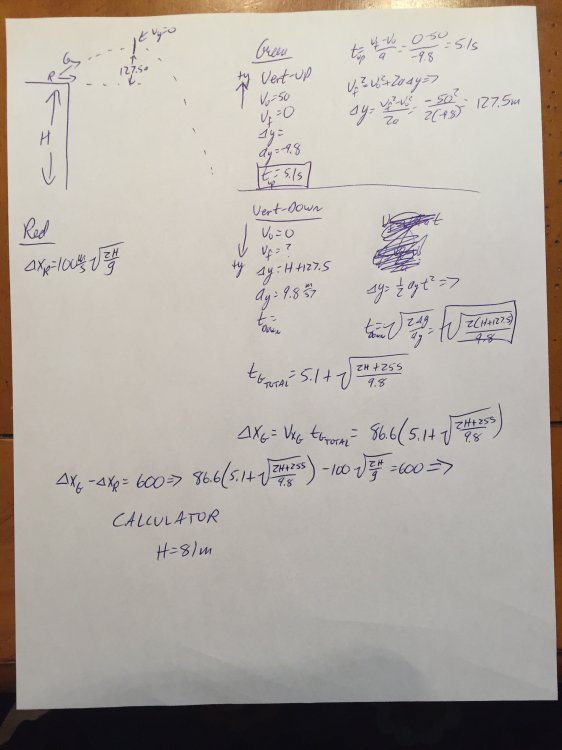-
Posts
2,778 -
Joined
-
Last visited
-
Days Won
49
Content Type
Profiles
Forums
Downloads
Blogs
Events
Store
Everything posted by FizziksGuy
-
Hmm... I was watching a cartoon of Sofia the First as she was helping flying horses last night and was wondering why their feet still run when their wings are flapping. Any ideas?
-
Some cool ones. I can't wait to try the sandwich bag and pencils tonight with my little ones!
-
Do you notice a lack of energy in these games compared to less windy games as you have to expend more energy as you run?
-

Wax: The key to snowboarding and skiing
FizziksGuy commented on ncharles's blog entry in Nate's Blog
Are there differences in friction based on the type of wax you use? -
Outstanding. Any other issues with the cool space sci-fi movies? There are tons to find!
-
Depends on what type of calculator you have. I use the "Solver" on my TI-85, but there are similar functions on most modern graphing calculators. On my TI-89 it looks like it's the "Numeric Solver." On the TI-84 it's under Math --> Solver.
-
Algebraically, separating out H would be a bit of a chore, and not one I really have the time to dive into right now (which is why the problem states that calculators are recommended).
-
-
Great analysis on the effects of the tennis court surface!
-
Name: Newton's Laws of Motion in Space: Force, Mass, and Acceleration Category: Dynamics Date Added: 2015-10-07 Submitter: FizziksGuy Uploaded on Apr 18, 2010ESA Science - Newton In Space (Part 2): Newton's Second Law of Motion - Force, Mass And Acceleration. Newton's laws of motion are three physical laws that form the basis for classical mechanics. They have been expressed in several different ways over nearly three centuries. --- Please subscribe to Science & Reason: • http://www.youtube.com/Best0fScience • http://www.youtube.com/ScienceMagazine • http://www.youtube.com/FFreeThinker --- The laws describe the relationship between the forces acting on a body and the motion of that body. They were first compiled by Sir Isaac Newton in his work "Philosophiæ Naturalis Principia Mathematica", first published on July 5, 1687. Newton used them to explain and investigate the motion of many physical objects and systems. For example, in the third volume of the text, Newton showed that these laws of motion, combined with his law of universal gravitation, explained Kepler's laws of planetary motion. --- Newton's Second Law of Motion: A body will accelerate with acceleration proportional to the force and inversely proportional to the mass. Observed from an inertial reference frame, the net force on a particle is equal to the time rate of change of its linear momentum: F = d(mv)/dt. Since by definition the mass of a particle is constant, this law is often stated as, "Force equals mass times acceleration (F = ma): the net force on an object is equal to the mass of the object multiplied by its acceleration." History of the second law Newton's Latin wording for the second law is: "Lex II: Mutationem motus proportionalem esse vi motrici impressae, et fieri secundum lineam rectam qua vis illa imprimitur." This was translated quite closely in Motte's 1729 translation as: "LAW II: The alteration of motion is ever proportional to the motive force impress'd; and is made in the direction of the right line in which that force is impress'd." According to modern ideas of how Newton was using his terminology, this is understood, in modern terms, as an equivalent of: "The change of momentum of a body is proportional to the impulse impressed on the body, and happens along the straight line on which that impulse is impressed." Motte's 1729 translation of Newton's Latin continued with Newton's commentary on the second law of motion, reading: "If a force generates a motion, a double force will generate double the motion, a triple force triple the motion, whether that force be impressed altogether and at once, or gradually and successively. And this motion (being always directed the same way with the generating force), if the body moved before, is added to or subtracted from the former motion, according as they directly conspire with or are directly contrary to each other; or obliquely joined, when they are oblique, so as to produce a new motion compounded from the determination of both." The sense or senses in which Newton used his terminology, and how he understood the second law and intended it to be understood, have been extensively discussed by historians of science, along with the relations between Newton's formulation and modern formulations. Newton's Laws of Motion in Space: Force, Mass, and Acceleration
-
Great question... although I'm a bit concerned about some of our drivers () adding a 3rd dimension of travel to worry about in their cars.
-
AND..... it's almost apple pie season!
-
Version 1.0.0
307 downloads
Projectile motion simulation lab activity using an Excel spreadsheet. Students input angle, launch speed and can trace path of projectile, view velocity vector, etc. Thanks to Ed Pogozelski (SUNY Geneseo) and Dan Baker (U of Rochester) for their assistance in creating this activity.Free-
- 1
-

-
- projectile motion
- projectiles
-
(and 2 more)
Tagged with:
-
View File SimuLAB: Projectile Motion (Excel) Projectile motion simulation lab activity using an Excel spreadsheet. Students input angle, launch speed and can trace path of projectile, view velocity vector, etc. Thanks to Ed Pogozelski (SUNY Geneseo) and Dan Baker (U of Rochester) for their assistance in creating this activity. Submitter FizziksGuy Submitted 10/05/2015 Category Kinematics
-
- excel
- projectiles
-
(and 2 more)
Tagged with:
-

so much for that last blog post
FizziksGuy commented on hannahbananaa00's blog entry in Hannah's Blog
I figured it was probably my fault... glad everyone was OK! -
Version 1.0.0
131 downloads
Write up for an open-ended "popper" lab in which students use their kinematic equations to determine the launch velocity of a popper toy. Popper toys can be found in a variety of places such as Amazon, CVS and Wal-Mart, as well as Oriental Trading. CVS Spring Toys item number is SKU# 439412, bar code 50428 06656, "Spring Up & Catch Game", $2.99 each or 2/$5 Walmart item number is #ES-41035, 6 to a package for $2.98, called the "Sport Pop-Up Game", bar code 79940 41035Free -
View File LAB: Popper Lab Write up for an open-ended "popper" lab in which students use their kinematic equations to determine the launch velocity of a popper toy. Popper toys can be found in a variety of places such as Amazon, CVS and Wal-Mart, as well as Oriental Trading. CVS Spring Toys item number is SKU# 439412, bar code 50428 06656, "Spring Up & Catch Game", $2.99 each or 2/$5 Walmart item number is #ES-41035, 6 to a package for $2.98, called the "Sport Pop-Up Game", bar code 79940 41035 Submitter FizziksGuy Submitted 09/30/2015 Category Kinematics
-
- kinematics
- free fall
-
(and 2 more)
Tagged with:
-

it's time to wear helmets while driving people!!!
FizziksGuy commented on hannahbananaa00's blog entry in Hannah's Blog
I wondered why my insurance rates jumped up last week... be safe! And of course, don't drink and derive. -
I think kateh516's tackle needs a bit more explanation...
-

What would happen if gravity pulled in the opposite direction?
FizziksGuy commented on kateh516's blog entry in Just Some Thoughts on Physics
I'd trip a bunch of people on their way into the school and watch them float up if gravity worked in the opposite direction. Don't worry, I've thought this through... I have a list! -
Version 1.0.0
68 downloads
Students use their knowledge of acceleration and kinematic equations to find the acceleration of two different balls rolling down an incline. A nice "early lab activity" following introduction of the kinematic equations to get students a hands-on application of their problem-solving principles as well as continued development of general measurement and lab procedures.Free -
LAB: How Does a Ball Roll View File Students use their knowledge of acceleration and kinematic equations to find the acceleration of two different balls rolling down an incline. A nice "early lab activity" following introduction of the kinematic equations to get students a hands-on application of their problem-solving principles as well as continued development of general measurement and lab procedures. Submitter FizziksGuy Submitted 09/21/2015 Category Kinematics
-
Name: Super Fast Cameras Category: Other Date Added: 2015-09-21 Submitter: FizziksGuy Researchers at MIT have created a camera with a resolution of one frame per trillionth of a second, allowing them to film light as it travels. Super Fast Cameras
-
The physics of bussing. I love it!
-
Sounds like a fun and challenging year ahead!
Terms of Use
The pages of APlusPhysics.com, Physics in Action podcasts, and other online media at this site are made available as a service to physics students, instructors, and others. Their use is encouraged and is free of charge. Teachers who wish to use materials either in a classroom demonstration format or as part of an interactive activity/lesson are granted permission (and encouraged) to do so. Linking to information on this site is allowed and encouraged, but content from APlusPhysics may not be made available elsewhere on the Internet without the author's written permission.
Copyright Notice
APlusPhysics.com, Silly Beagle Productions and Physics In Action materials are copyright protected and the author restricts their use to online usage through a live internet connection. Any downloading of files to other storage devices (hard drives, web servers, school servers, CDs, etc.) with the exception of Physics In Action podcast episodes is prohibited. The use of images, text and animations in other projects (including non-profit endeavors) is also prohibited. Requests for permission to use such material on other projects may be submitted in writing to info@aplusphysics.com. Licensing of the content of APlusPhysics.com for other uses may be considered in the future.




